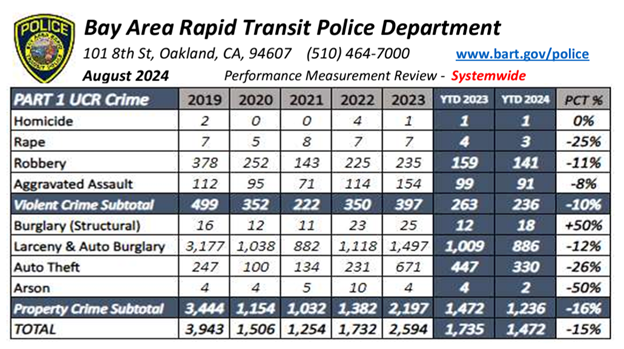Search Results
"Spare the Air," sports events, boost BART ridership
Three consecutive "Spare the Air" days in a week of high temperatures, along with sporting events, have helped boost ridership on BART to the highest numbers in more than a year, excluding during the planned and emergency closures of the Bay Bridge in 2009. On Wednesday -- this week's first Spare the Air day
BART sees double digit drop in crime
The latest numbers from the BART Police Department show through the end of August overall crime in the system is down 15% compared with the same period in 2023. The trend includes a 10% drop in violent crime. The decline in the crime rate comes as BART has been experiencing an increase in ridership. All of BART’s top 10 post-pandemic ridership days were in September, driven by special events including the Dreamforce conference in San Francisco and the final Oakland A’s homestand. Read the full Chief’s Report with all the latest safety numbers.
“The drop in criminal activity on BART is happening as we have been going all out to implement our Safe and Clean Plan,” said BART General Manager Bob Powers. “Our riders have been loud and clear that they want us to step our game up when it comes to their safety and the cleanliness of our system. We have more work to do on behalf of our riders, but these numbers indicate our commitment to maximizing our visible safety presence is paying off.”
“Since I became BART Police Chief one year ago, it has been my top priority to maximize the number of officers walking trains and patrolling our stations,” said BART Police Chief Kevin Franklin. “Our officers are more visible than ever. Their efforts are containing relatively small concerns before they grow into big problems that harm service.”

Additional safety highlights from the latest numbers:
*Only 12 electronic thefts and robberies were reported across the entire system in August. That’s the lowest total for any month since 2021 when ridership was much lower than today.
*BART PD reported 13,016 total enforcement contacts through August, up from 7,791 for the same period in 2023.
*BART PD’s response time for Priority 1 emergencies averaged 4 minutes and 25 seconds in August, among the fastest for any law enforcement agency in the Bay Area.
BART’s Safe and Clean Plan is a commitment to riders to maximize resources to boost their safety and provide clean service. BART’s stepped up safety efforts include sworn officers, non-sworn Crisis Intervention Specialists and Transit Ambassadors, as well as the implementation of Next Generation Fare Gates, which have now been installed successfully at seven stations. All 50 of BART’s stations will have Next Generation Fare Gates by the end of 2025.
BART PD patrols a system that spans five counties and includes 50 stations with 131 route miles of track. You can keep up with all BART’s safety trends in the monthly Chief’s Reports.
BART will operate on a regular Saturday schedule on Labor Day
On Labor Day, Monday, September 3rd, BART will operate on a regular Saturday schedule. There will be no overnight BART service from 1 a.m. ? 4 a.m. on the morning of Tuesday, September 4th even though the Bay Bridge will be closed during this time. Regular BART weekday service will resume Tuesday, September
BART to run longer trains for holiday shoppers & travelers
Regular Sunday Service Scheduled for Christmas Day BART will run longer trains on the line servicing San Francisco International and Oakland International airports as well as popular shopping destinations on Friday, December 23 and Saturday, December 24, 2005. Eight or nine car trains will run on the Dublin
BART's online EZ Rider system back in service
The EZ Rider systems is back in service as of July 6, 2022. The BART EZ Rider system is currently down. We are hoping to get the system back in service before the end of the week (July 8, 2022). This impacts BART’s EZ Rider Parking program and the Airport Employee Discount Program. Users will be unable to
BART Board to meet Thursday, Oct. 23, at 4 pm
The BART Board of Directors is scheduled to meet Thursday, Oct. 23, at 4 pm, to take up a number of issues including an amended Financial Stability Policy creating a larger reserve fund for times of economic uncertainty. The amended policy would increase the reserve fund from 5% of total annual operating
BART explores late-night bus service options
The BART Board considered the late Friday Night Service Demonstration proposal at Thursday's regular Board meeting and decided to keep Saturday morning service intact. (To view details of the proposal go to the Board Agenda and Minutes page, click on "Agenda" for the Nov. 17, 2011, meeting, and go to the PDF
BART bond money for system needs only – not salaries
BART has placed a $3.5 billion bond measure on the November ballot to rebuild our aging system for the sake of safety, reliability, and traffic relief. Not one penny, under any circumstance, can or will be used to pay for operating expenses, salaries, or benefits. The money is only for improvements like
Temporary changes to parking lots at Hayward BART station
On Thursday, June 15, BART began to repave the parking lots at the Hayward BART Station. Throughout this month-long project, there will be temporary changes to where parking will be permitted. BART is doing the work in three phases. Phase I: Repaving the disabled parking lot began on Thursday, June 15 and the
BART Police arrest two suspects in Saturday shooting
The two suspects in Saturday’s shooting at West Oakland Station are in custody this morning because of an observant BART Police Officer who initiated a safe apprehension. Officer Francisco Rodriguez was patrolling the Montgomery Street Station platform last night when at 6:50pm he recognized a man and woman